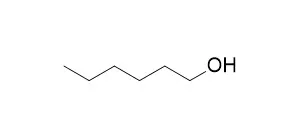| In vitro: |
| Energy & Fuels, 2010, 24(NOV.-DEC.):5859-5875. | | Experimental and Detailed Kinetic Modeling Study of 1-Hexanol Oxidation in a Pressurized Jet-Stirred Reactor and a Combustion Bomb.[Reference: WebLink] | 1-Hexanol is among the promising renewable long-chain alcohols usable as an alternative to petrol-derived gasoline and diesel fuels. To better understand the combustion characteristics of 1-Hexanol, new experimental data for the oxidation and combustion of 1-Hexanol were obtained.
METHODS AND RESULTS:
Stable species concentration profiles were measured in a jet stirred reactor (JSR) at 10 atm over a range of equivalence ratios and temperatures. Burning velocities of 1-Hexanol/air mixtures were measured at 1−10 bar and 423 K, over a range of equivalence ratios. The effect of total pressure on flame speed was determined. The oxidation of 1-Hexanol in these experimental conditions was modeled using an extended detailed chemical kinetic reaction mechanism (2977 reactions involving 600 species).
CONCLUSIONS:
The proposed mechanism shows good agreement with the present experimental data. Reaction path analyses and sensitivity analyses were performed to interpret the results. | | Biochimica Et Biophysica Acta, 1996, 1274(1-2):39-47. | | The nature of uncoupling by n-hexane, 1-hexanethiol and 1-hexanol in rat liver mitochondria.[Pubmed: 8645693] |
METHODS AND RESULTS:
We have analyzed the effects of n-, 1-hexanethiol, and 1-Hexanol on the coupled respiration of liver mitochondria. Incubation of mitochondria with n-, 1-hexanethiol and 1-Hexanol resulted in a stimulation, at low concentrations, and an inhibition, at high concentrations, of the state 4 mitochondrial respiration. Three criteria, all based on the comparison with the effect of , have been used to establish whether the stimulation of respiration, at low concentrations of n-, 1-hexanethiol, and 1-Hexanol, depends on protonophoric mechanisms.
CONCLUSIONS:
First, the quantitative relationship between the extents of respiratory stimulation and potential : a strong decrease of potential was induced by increasing concentrations of and a negligible by increasing concentrations of n-or 1-hexanethiol. Only a slight decrease was induced by 1-Hexanol. Second, the quantitative relationship between the extents of respiratory stimulation and of proton conductance increase: at equivalent rates of respiration, the enhancement of the proton conductance induced by was very marked, by n-and 1-hexane |
|






 Cell. 2018 Jan 11;172(1-2):249-261.e12. doi: 10.1016/j.cell.2017.12.019.IF=36.216(2019)
Cell. 2018 Jan 11;172(1-2):249-261.e12. doi: 10.1016/j.cell.2017.12.019.IF=36.216(2019) Cell Metab. 2020 Mar 3;31(3):534-548.e5. doi: 10.1016/j.cmet.2020.01.002.IF=22.415(2019)
Cell Metab. 2020 Mar 3;31(3):534-548.e5. doi: 10.1016/j.cmet.2020.01.002.IF=22.415(2019) Mol Cell. 2017 Nov 16;68(4):673-685.e6. doi: 10.1016/j.molcel.2017.10.022.IF=14.548(2019)
Mol Cell. 2017 Nov 16;68(4):673-685.e6. doi: 10.1016/j.molcel.2017.10.022.IF=14.548(2019)